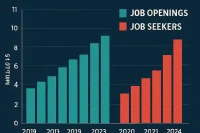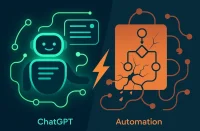General Motors (GM) is laying off nearly 1,000 workers, primarily in the United States, as part of a broader strategy to streamline operations and reduce costs.
The layoff were confirmed by the Detroit-based automaker on Friday.
They reflect the company’s efforts to position itself as a leader in the electric vehicle (EV) and software markets—areas that have proven both costly and highly competitive.
GM’s Cost-Cutting Strategy
In its statement, GM did not specify the exact number of job cuts but acknowledged a “small number of team reductions” aimed at optimizing the business for “speed and excellence.”
The latest round of layoffs includes 507 employees at GM’s tech center in Warren, Michigan, according to a state filing.
The move comes as the company looks to cut between $2 billion and $4 billion in losses related to its EV operations next year.
The automaker’s restructuring efforts are part of a larger industry trend, with carmakers globally facing pressure to make electric vehicles profitable while competing against dominant players like Tesla and emerging Chinese automakers.
Need Career Advice? Get employment skills advice at all levels of your career
Recent Layoffs Highlight Broader Restructuring
The job cuts announced this week follow several rounds of significant layoffs by GM earlier this year:
- August 2024: GM laid off more than 1,000 workers in its software department as part of a team streamlining initiative.
- September 2024: The company cut approximately 1,700 jobs at a Kansas manufacturing plant.
- 2023 Buyouts: Around 5,000 salaried employees took buyouts, marking one of GM’s most substantial reductions in recent years.
These moves underscore GM’s ongoing effort to control costs while scaling up its EV production capabilities.
The automaker aims to offset substantial losses in its electric vehicle segment, which remains a key focus as the industry shifts away from traditional combustion engines.
Looking for a job? Visit www.whatjobs.com today
A Broader Industry Trend: Automakers Cut Jobs Amid EV Transition
General Motors is not alone in its aggressive cost-cutting measures.
Across the automotive industry, companies are laying off workers and adjusting production schedules as they navigate the transition to electric vehicles and contend with slowing demand.
Hiring? Post jobs for free with WhatJobs
Stellantis and Ford Also Trim Workforce
Detroit’s other major automakers are facing similar challenges:
- Stellantis: The company laid off thousands of salaried and hourly employees this year, including 2,450 workers at a Michigan plant in August and 1,100 workers at an Ohio plant in early November.
- Ford Motor: Ford reduced shifts at its F-150 Lightning electric pickup plant in Michigan, which will be idled through the end of the year due to weaker-than-expected demand for the vehicle.
These cuts highlight the difficulties traditional automakers face as they scale up EV production while trying to maintain profitability.
The competition from Tesla, which has established itself as the dominant EV player, as well as from rapidly growing Chinese automakers, is forcing legacy carmakers to rethink their strategies and streamline their operations.
Global Layoffs Reflect Industry-Wide Challenges
The challenges are not confined to U.S. automakers. Global car manufacturers, including Nissan and Volkswagen, have also issued warnings about potential layoffs as they struggle with the financial pressures of transitioning to electric vehicle production.
The Push for EV Profitability
GM’s latest round of layoffs comes as the company intensifies its focus on electric vehicles and software development—two areas CEO Mary Barra has identified as critical to the company’s future success.
However, scaling up EV production has proven costly, and the company is grappling with the challenge of making electric vehicles profitable in a competitive market.
The decision to cut nearly 1,000 jobs is part of GM’s broader strategy to manage expenses while investing heavily in EV technology.
The automaker has made significant investments in battery technology and EV infrastructure, but profitability remains elusive as high production costs and supply chain issues continue to weigh on the bottom line.
Aiming to Compete with Tesla and Chinese Automakers
GM’s cost-cutting measures reflect its need to compete with Tesla, which has maintained a dominant market position thanks to its established EV infrastructure and streamlined production processes.
Additionally, Chinese automakers have rapidly expanded their EV offerings, putting further pressure on traditional carmakers to innovate and reduce costs.
The race to make EVs profitable has led to a wave of layoffs across the industry as companies look to cut non-essential roles and focus resources on high-growth areas.
GM’s job cuts are the latest indication of how challenging this transition has been, even for well-established automakers.
What’s Next for GM?
As GM navigates its restructuring and cost-cutting efforts, the company’s success will hinge on its ability to bring profitable electric vehicles to market and capitalize on the growing demand for EVs.
Despite the layoffs, GM remains committed to its vision of a future dominated by electric and autonomous vehicles.
A General Motors statement said:
“In order to win in this competitive market, we need to optimize for speed and excellence.”
The company’s focus on efficiency and its willingness to make tough decisions suggest that it is prepared to make the necessary changes to secure its position in the evolving automotive landscape.
The Broader Outlook: An Industry in Transition
The layoffs at General Motoes are part of a larger pattern across the global automotive industry, where carmakers are grappling with the financial pressures of shifting from traditional vehicles to electric models.
The move towards electrification is reshaping the industry, forcing companies to rethink their workforce strategies, streamline operations, and invest in new technologies.
With the industry in a state of flux, automakers will continue to face tough choices as they work to balance the costs of innovation with the need for profitability.
GM’s recent actions highlight the difficulties of this transition, but also reflect a commitment to adapting and evolving in response to a rapidly changing market.




